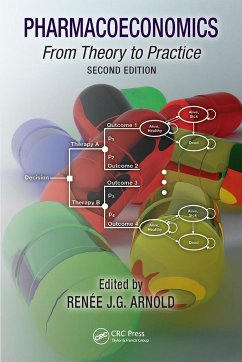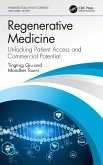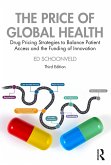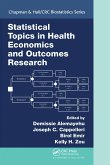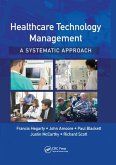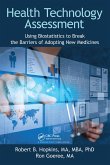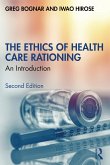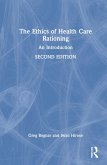In this era of finite budgets, healthcare rationing, medication shortages, and the global aging and burgeoning of populations, numerous stakeholders in the healthcare arena must understand the basic principles of pharmacoeconomics and how these may be correctly applied to facilitate drug development, rationing, patient segmentation, disease management, and pricing model development.
Pharmacoeconomics: From Theory to Practice, Second Edition focuses on how to more efficiently and rationally leverage these healthcare resources, not by restricting access to necessary services, but by using them more efficiently. This updated volume arms decision makers with the tools they need to make wise choices in an area where the stakes are extremely high-the health of the global population.
Key Features:
Introduces the major concepts and principles of PharmacoeconomicsGives updated information about pharmacoeconomic models, value-based pricing, novel modelling methodologies and international utilization of these modalities in government, the pharmaceutical industry, and health care settingsDemonstrates the full range of ethical and moral issues, as well as overall public health and commercial concerns that are often involved in decisions entailing pharmacoeconomic issuesPresents both theory and methodology discussions, including real-world examples, in each chapter
'The methods and application of pharmacoeconomics are rapidly evolving, so the new edition of this textbook is very timely. It provides an excellent introduction for those new to the field, whether they be students, professionals within the pharmaceutical industry, or health care professionals more generally. A particularly useful feature of the book is that it gives an introduction both to the main methods used in pharmacoeconomics studies and how these studies are used in decisions about the reimbursement or appropriate use of medicines in several countries.'
- Michael Drummond, Professor of Health Economics, University of York
Pharmacoeconomics: From Theory to Practice, Second Edition focuses on how to more efficiently and rationally leverage these healthcare resources, not by restricting access to necessary services, but by using them more efficiently. This updated volume arms decision makers with the tools they need to make wise choices in an area where the stakes are extremely high-the health of the global population.
Key Features:
Introduces the major concepts and principles of PharmacoeconomicsGives updated information about pharmacoeconomic models, value-based pricing, novel modelling methodologies and international utilization of these modalities in government, the pharmaceutical industry, and health care settingsDemonstrates the full range of ethical and moral issues, as well as overall public health and commercial concerns that are often involved in decisions entailing pharmacoeconomic issuesPresents both theory and methodology discussions, including real-world examples, in each chapter
'The methods and application of pharmacoeconomics are rapidly evolving, so the new edition of this textbook is very timely. It provides an excellent introduction for those new to the field, whether they be students, professionals within the pharmaceutical industry, or health care professionals more generally. A particularly useful feature of the book is that it gives an introduction both to the main methods used in pharmacoeconomics studies and how these studies are used in decisions about the reimbursement or appropriate use of medicines in several countries.'
- Michael Drummond, Professor of Health Economics, University of York
The methods and application of pharmacoeconomics are rapidly evolving, so the new edition of this textbook is very timely. It provides an excellent introduction for those new to the field, whether they be students, professionals within the pharmaceutical industry, or health care professionals more generally. A particularly useful feature of the book is that it gives an introduction both to the main methods used in pharmacoeconomics studies and how these studies are used in decisions about the reimbursement or appropriate use of medicines in several countries.
- Michael Drummond, Professor of Health Economics, University of York
After reading this substantial book I found a new respect for the impact of the title on the world of medical care. As a clinical endocrinologist, along with most of my colleagues working to obtain the best possible therapies for our patients, I often found myself confused and frustrated by the systems (at least here in the U.S) preventing me from ordering the latest and greatest treatments. Dr. Arnold's work provides an excellent framework to understand how some decisions are made currently in introducing new medicines, surgeries and other modalities to caregivers. Each chapter provides a concise summary of the most important principles of the quantitative and qualitative methods used both here in the United States and around the world. Several of the authors acknowledge that some of the "standards" such as QALY (quality -adjusted life year) CEA (cost effectiveness analysis) and others may not be the best method of assessing value for a new medication. The complexity of weighing the value involving a balance between economic, social and resource allocation is well addressed both with explanations and examples. I feel a bit more competent in understanding the literature that often addresses these principles after carefully absorbing this work. It will remain a handy reference for my electronic shelf (until the third edition comes out!). Kudos to all of the authors, I hope that some of the new approaches discussed become part of the mainstream to allow for a better way to encourage innovation while still maximizing our limited resources.
- Jerome Fischer, Diabetes and Glandular Disease Clinic (DGDC)
Renee Arnold has collaborated with some of the top experts in the discipline of pharmacoeconomics to produce a great resource which will be helpful for those new to the field and those wanting to understand more about the topic, as well as students of this discipline. Each chapter is dedicated to a particular topic and provides a clear, readable and understandable overview. Additionally, many practical, relevant and timely examples are used to illustrate the theory and really bring the material to life. These examples will be helpful to those working in this field and those seeking to understand the application of health economics. The topics covered include all of those you would expect but also stretch beyond the typical subjects to include chapters on multicriteria decision analysis, machine learning and speculations about the future. A final chapter touches on some of the learnings in the era of COVID19 and how pharmacoeconomics can help objectively determine how to efficiently invest in future healthcare.
- Louise Timlin, Senior Director - Global Health Outcomes, UK
- Michael Drummond, Professor of Health Economics, University of York
After reading this substantial book I found a new respect for the impact of the title on the world of medical care. As a clinical endocrinologist, along with most of my colleagues working to obtain the best possible therapies for our patients, I often found myself confused and frustrated by the systems (at least here in the U.S) preventing me from ordering the latest and greatest treatments. Dr. Arnold's work provides an excellent framework to understand how some decisions are made currently in introducing new medicines, surgeries and other modalities to caregivers. Each chapter provides a concise summary of the most important principles of the quantitative and qualitative methods used both here in the United States and around the world. Several of the authors acknowledge that some of the "standards" such as QALY (quality -adjusted life year) CEA (cost effectiveness analysis) and others may not be the best method of assessing value for a new medication. The complexity of weighing the value involving a balance between economic, social and resource allocation is well addressed both with explanations and examples. I feel a bit more competent in understanding the literature that often addresses these principles after carefully absorbing this work. It will remain a handy reference for my electronic shelf (until the third edition comes out!). Kudos to all of the authors, I hope that some of the new approaches discussed become part of the mainstream to allow for a better way to encourage innovation while still maximizing our limited resources.
- Jerome Fischer, Diabetes and Glandular Disease Clinic (DGDC)
Renee Arnold has collaborated with some of the top experts in the discipline of pharmacoeconomics to produce a great resource which will be helpful for those new to the field and those wanting to understand more about the topic, as well as students of this discipline. Each chapter is dedicated to a particular topic and provides a clear, readable and understandable overview. Additionally, many practical, relevant and timely examples are used to illustrate the theory and really bring the material to life. These examples will be helpful to those working in this field and those seeking to understand the application of health economics. The topics covered include all of those you would expect but also stretch beyond the typical subjects to include chapters on multicriteria decision analysis, machine learning and speculations about the future. A final chapter touches on some of the learnings in the era of COVID19 and how pharmacoeconomics can help objectively determine how to efficiently invest in future healthcare.
- Louise Timlin, Senior Director - Global Health Outcomes, UK

